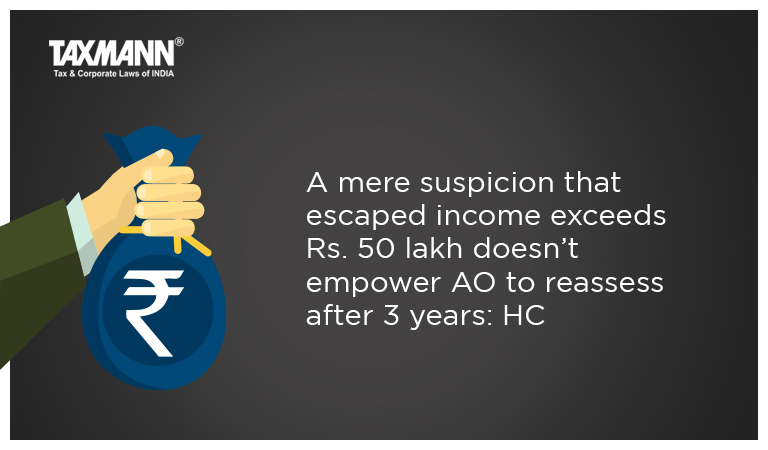A mere suspicion that escaped income exceeds Rs. 50 lakh doesn’t empower AO to reassess after 3 years: HC
- Blog|News|Income Tax|
- 2 Min Read
- By Taxmann
- |
- Last Updated on 25 July, 2022

Case Details: Abdul Majeed Son of Shri Ali Mohammed v. ITO - [2022] 140 taxmann.com 485 (Rajasthan)
Judiciary and Counsel Details
-
- Manindra Mohan Shrivastava & Mrs Shubha Mehta, JJ.
- Siddharth Ranka, Muzaffar Iqbal, Saurav Harsh and Ms Apeksha Bapna, Advs. for the Petitioner.
- Amit Malani and Nikhil Simlote, Advs. for the Respondent.
Facts of the Case
Assessee filed the writ petition against order passed by Assessing Officer (AO) initiating proceedings under Section 148A(d). AO formed an opinion that income chargeable to tax has escaped assessment.
AO issued notice under Section 148A(b) based on certain information which suggested that income chargeable to tax for the assessment year 2015-2016 has escaped assessment.
High Court Held
The Rajasthan High Court held that undisputedly it was a case where more than 3 years have elapsed from the end of the relevant assessment year. Thus, to initiate proceeding under Sections 148, it is not only required to be shown that some income chargeable to tax has escaped assessment, but also that it amounts to or is likely to amount to Rs. 50 lakhs or more than for that year.
In the given case, no material has been placed to show that at the time when AO passed order under Section 148A, there was some material on record that the income chargeable to tax that escaped assessment amount to or is likely to amount Rs.50,00,000/- or more for that year.
An inference drawn by AO was on the basis that an account in which undisclosed cash deposits of more than Rs. 19,00,000/- were made itself suggests that the assessee, who is otherwise an NRI, may have many more bank accounts.
The impediment placed by section 149(1)(b) on reopening the assessment can be overcome by bringing in more tangible material on record which shows escapement of Income/asset/expenditure/entry of Rs.50 lakhs or more and not by surmises that there may be more suppressed bank accounts of assessee and escapement will likely be Rs. 50 lakhs or more.
If such an interpretation is placed on the provision of Section 148A(d) with reference to the expression ‘material available on record’, then, in that case, it will open flood gate and even without the availability of any material, AO would be initiating proceedings under Section 148, which will completely frustrate the object of incorporation of Section 148A.
Disclaimer: The content/information published on the website is only for general information of the user and shall not be construed as legal advice. While the Taxmann has exercised reasonable efforts to ensure the veracity of information/content published, Taxmann shall be under no liability in any manner whatsoever for incorrect information, if any.

Taxmann Publications has a dedicated in-house Research & Editorial Team. This team consists of a team of Chartered Accountants, Company Secretaries, and Lawyers. This team works under the guidance and supervision of editor-in-chief Mr Rakesh Bhargava.
The Research and Editorial Team is responsible for developing reliable and accurate content for the readers. The team follows the six-sigma approach to achieve the benchmark of zero error in its publications and research platforms. The team ensures that the following publication guidelines are thoroughly followed while developing the content:
- The statutory material is obtained only from the authorized and reliable sources
- All the latest developments in the judicial and legislative fields are covered
- Prepare the analytical write-ups on current, controversial, and important issues to help the readers to understand the concept and its implications
- Every content published by Taxmann is complete, accurate and lucid
- All evidence-based statements are supported with proper reference to Section, Circular No., Notification No. or citations
- The golden rules of grammar, style and consistency are thoroughly followed
- Font and size that’s easy to read and remain consistent across all imprint and digital publications are applied




